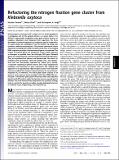| dc.contributor.author | Zhao, Dehua | |
| dc.contributor.author | Voigt, Christopher A. | |
| dc.contributor.author | Temme, Karsten | |
| dc.date.accessioned | 2014-08-26T16:25:11Z | |
| dc.date.available | 2014-08-26T16:25:11Z | |
| dc.date.issued | 2012-04 | |
| dc.date.submitted | 2011-12 | |
| dc.identifier.issn | 0027-8424 | |
| dc.identifier.issn | 1091-6490 | |
| dc.identifier.uri | http://hdl.handle.net/1721.1/89066 | |
| dc.description.abstract | Bacterial genes associated with a single trait are often grouped in a contiguous unit of the genome known as a gene cluster. It is difficult to genetically manipulate many gene clusters because of complex, redundant, and integrated host regulation. We have developed a systematic approach to completely specify the genetics of a gene cluster by rebuilding it from the bottom up using only synthetic, well-characterized parts. This process removes all native regulation, including that which is undiscovered. First, all noncoding DNA, regulatory proteins, and nonessential genes are removed. The codons of essential genes are changed to create a DNA sequence as divergent as possible from the wild-type (WT) gene. Recoded genes are computationally scanned to eliminate internal regulation. They are organized into operons and placed under the control of synthetic parts (promoters, ribosome binding sites, and terminators) that are functionally separated by spacer parts. Finally, a controller consisting of genetic sensors and circuits regulates the conditions and dynamics of gene expression. We applied this approach to an agriculturally relevant gene cluster from Klebsiella oxytoca encoding the nitrogen fixation pathway for converting atmospheric N[subscript 2] to ammonia. The native gene cluster consists of 20 genes in seven operons and is encoded in 23.5 kb of DNA. We constructed a “refactored” gene cluster that shares little DNA sequence identity with WT and for which the function of every genetic part is defined. This work demonstrates the potential for synthetic biology tools to rewrite the genetics encoding complex biological functions to facilitate access, engineering, and transferability. | en_US |
| dc.language.iso | en_US | |
| dc.publisher | National Academy of Sciences (U.S.) | en_US |
| dc.relation.isversionof | http://dx.doi.org/10.1073/pnas.1120788109 | en_US |
| dc.rights | Article is made available in accordance with the publisher's policy and may be subject to US copyright law. Please refer to the publisher's site for terms of use. | en_US |
| dc.source | PNAS | en_US |
| dc.title | Refactoring the nitrogen fixation gene cluster from Klebsiella oxytoca | en_US |
| dc.type | Article | en_US |
| dc.identifier.citation | Temme, K., D. Zhao, and C. A. Voigt. “Refactoring the Nitrogen Fixation Gene Cluster from Klebsiella oxytoca.” Proceedings of the National Academy of Sciences 109, no. 18 (April 16, 2012): 7085–7090. | en_US |
| dc.contributor.department | Massachusetts Institute of Technology. Department of Biological Engineering | en_US |
| dc.contributor.mitauthor | Zhao, Dehua | en_US |
| dc.contributor.mitauthor | Voigt, Christopher A. | en_US |
| dc.relation.journal | Proceedings of the National Academy of Sciences | en_US |
| dc.eprint.version | Final published version | en_US |
| dc.type.uri | http://purl.org/eprint/type/JournalArticle | en_US |
| eprint.status | http://purl.org/eprint/status/PeerReviewed | en_US |
| dspace.orderedauthors | Temme, K.; Zhao, D.; Voigt, C. A. | en_US |
| dc.identifier.orcid | https://orcid.org/0000-0003-0844-4776 | |
| mit.license | PUBLISHER_POLICY | en_US |
| mit.metadata.status | Complete | |
